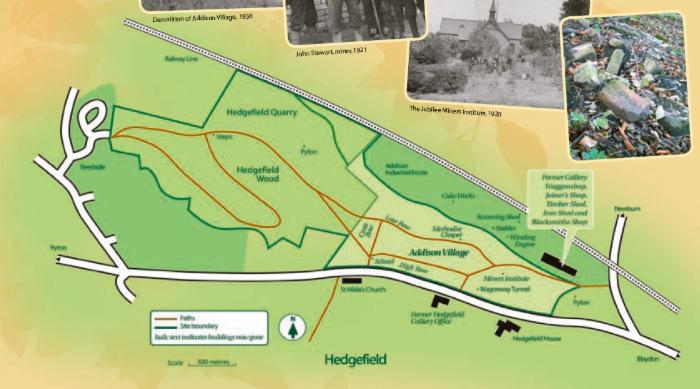
Addison Colliery
Opened/Sunk: 1864
Closed: 1963

Photographer: Unknown
Date: Date Unknown
Reference Number: GL000450
Item Description: Addison Colliery was sunk in 1864 and rows of colliery houses were constructed to accommodate the miners and their families. Addison was a thriving community but after the closure of the pit in the 1950s the village declined. Shortly afterwards Addison was declared a Category D village and the houses and colliery were demolished. The area has now reverted to woodland and relatively little trace of the village can be seen.

This area has probably been mined since Roman times. In the 16th Century the Bishop of Durham granted mining rights to Queen Elizabeth I. This ‘Grand Lease’ was eventually taken up by Stella Coal Company.
The 'first sod' at Addison Pit was cut, by Mrs Addison
Potter, on the 26th January 1863 in an impressive ceremony before a
large crowd. The name Addison was chosen in honour of Mr Addison Potter
whose family had a long connection with Townley Colliery.
The shafts were sunk in 1865 to a depth of 68 Fathoms (408
feet or 124m. This is equal to 5 Angels of the North on top of each
other!) Two drift mines, Kitty and Atkinson also operated. The former
was used as an air raid shelter during World War II.
The pit closed in December 1963, employing just 150 men.
Today one of the pit buildings survives on Addison Industrial Estate.
This was the waggonshop, joiner’s shop and blacksmith’s shop. An
entrance to a waggonway tunnel also survives.
For more

Advertisement


Addison Colliery was the property of the Stella Coal Company, the pit being sunk in 1864. Addison Pit was situated close to the Newcastle & Carlisle Railway, to which it could be connected by a loop line. The mine workings ran westwards because of a large geological fault east of Addison village. It was eventually possible to walk underground from Addison to Clara Vale Pit. The name Addison came from Mr Addison Potter, whose family was connected with Towneley Colliery. Mrs Addison Potter cut the first sod of the Addison Pit in an impressive ceremony on January 26th 1864. Addison Pit was the first colliery in the world to have underground telephone. Experiments using Professor Graham Bell's telephone were carried out in 1877. It was connected to Hedgefield House in which John B. Simpson, one of the colliery directors, lived from 1864 to 1894. The first offices of the Coal Company were rooms in Hedgefield House. In 1894 separate offices were built.Hedgefield House is now a hotel. In 1883 the output of coal was 120,000 tons, with about 500 men and boys employed. In 1894 the output of coal was 254,000 tons and 1,000 workmen. By 1923 the output was 1,058,740 tons with 5,500 workmen. A little west of Addison Pit was an old shaft, formerly used as a pumping shaft to clear Stargate from water. The shafts at Addison were sunk in 1865 but coal was also drawn from two drift mines, the Kitty and Atkinson Drifts. The winding engine was steam driven, installed by Sir William Armstrong of Elswick in 1864. In 1924 the Atkinson Drift was closed. It was later used as an air raid shelter in WW2. In 1946 there was an explosion in the pit which killed two people. The pit went into decline. The village was depopulated and finally abandoned in 1958. The houses were then demolished. The pit finally closed in 1963 {1}.
A search for Addison at gatesheadlocalstudies will bring many results
Addison Colliery Photos brought to you by
The Felling Heritage Group